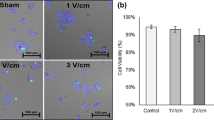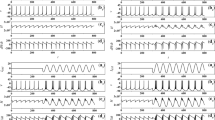Abstract
The production, distribution and use of electricity can generate low frequency electric and magnetic fields (50–60 Hz). Considering that some studies showed adverse effects on pancreatic β-cells exposed to these fields; the present study aimed to analyze the effects of 60 Hz electric fields on membrane potential during the silent and burst phases in pancreatic β-cells using a mathematical model. Sinusoidal 60 Hz electric fields with amplitude ranging from 0.5 to 4 mV were applied on pancreatic β-cells model. The sinusoidal electric field changed burst duration, inter-burst intervals (silent phase) and spike sizes. The parameters above presented dose-dependent response with the voltage amplitude applied. In conclusion, theoretical analyses showed that a 60 Hz electric field with low amplitudes changes the membrane potential in pancreatic β-cells.





Similar content being viewed by others
References
Abásolo D et al (2006) Analysis of EEG background activity in Alzheimer’s disease patients with Lempel–Ziv complexity and central tendency measure. Med Eng Phys 28:315–322
Aboy M, Hornero R, Absolo D, Alvarez D (2006) Interpretation of the Lempel–Ziv complexity measure in the context of biomedical signal analysis. IEEE Trans Biomed Eng 53:2282–2288. doi:10.1109/TBME.2006.883696
Barajas-Ramírez JG, Steur E, Femat R, Nijmeijer H (2011) Synchronization and activation in a model of a network of β-cells. Automatica 47:1243–1248. doi:10.1016/j.Automatica.02.041
Bertram R, Sherman A (2004a) A calcium-based phantom bursting model for pancreatic islets. B Math Biol 66:1313–1344. doi:10.1016/j.bulm.2003.12.005
Bertram R, Sherman A (2004b) Filtering of calcium transients by the endoplasmic reticulum in pancreatic β-Cells. Biophys J 87:3775–3785. doi:10.1529/biophysj.104.050955
Bertram R, Previte J, Sherman A, Kinard TA, Satin LS (2000) The phantom burster model for pancreatic β-cells. Biophys J 79:2880–2892
Bertram R, Satin L, Zhang M, Smolen P, Sherman A (2004) Calcium and glycolysis mediate multiple bursting modes in pancreatic islets. Biophys J 87(5):3074–3087. doi:10.1529/biophysj.104.049262
Braun M, Ramracheya R, Bengtsson M et al (2008) Voltage-gated ion channels in human pancreatic β-cells: electrophysiological characterization and role in insulin secretion. Diabetes 57:1618–1628. doi:10.2337/db07-0991
Cain CA (1980) Theoretical basis for microwave and RF field effects on excitable cellular membranes. IEEE Trans Microw Theory Techn 28:142–147
Cha CY, Powell T, Noma A (2011) Analyzing electrical activities of pancreatic β-cells using mathematical models. Prog Biophys Mol Biol 107:265–273. doi:10.1016/j.pbiomolbio.2011.08.00
Chang L, Wang J, Deng B, Wei X, Li H (2012) The effect of extreme low frequency external electric field on the adaptability in the Ermentrout model. Neurocomputing 81:67–74. doi:10.1016/j.neucom.2011.11.015
Cohen SD and Hindmarsh AC (1995) CVODE, A STIFF/NONSTIFF ODE SOLVER IN C. Numerical Mathematics Group. UCRL-JC-121014, Rev.1 http://computation.llnl.gov/casc/nsde/pubs/u121014.pdf
Coronel-Cruz C et al (2013) Connexin 30.2 is expressed in mouse pancreatic beta cells. Biochem Biophys Res Commun 6; 438(4):772–777 doi: 10.1016/j.bbrc.2013.06.100
Da Costa JG, de Moura MA, Consoni L, Nogueira RA (2002) Can electromagnetic radiations induce changes in the kinetics of voltage-dependent ion channels? Cell Mol Biol (Noisy-le-grand) 48(5):577–583
D’Aleo A, Mancarella R, Guerra SD, Boggi U, Filipponi F, Marchetti P, Lupi R (2011) Direct effects of rapid-acting insulin analogues on insulin signaling in human pancreatic islets in vitro. Diabetes Metab 37:324–329. doi:10.1016/j.diabet.2010.12.002
Ding et al (1996) A possible role of the ATP-sensitive potassium ion channel in determining the duration of spike-bursts in mouse pancreatic β-cells. Biochim Biophys Acta 1279:219–226
Ermentrout B (1987) Simulating, Analyzing, and Animating Dynamical Systems: A Guide to XPPAUT for Researchers and Students. SIAM, Philadelphia
Fan J et al (2012) Effect of pulse magnetic field stimulation on calcium channel current. J Magn Magn Mater 324:3491–3494. doi:10.1016/j.jmmm.2012.02.073
Fridlyand LE, Tamarina N, Philipson LH (2010) Bursting and calcium oscillations in pancreatic β-cells: specific pacemakers for specific mechanisms. Am J Physiol Endocrinol Metab 299:E517–E532. doi:10.1152/ajpendo.00177.2010
Gholampour F, Javadifar TS, Owji SM, Bahaoddini A (2011) Prolonged exposure to extremely low frequency electromagnetic field affects endocrine secretion and structure of pancreas in rats. Int J Zool Res 7(4):338–344. doi:10.3923/ijzr.2011
Grassi C, D’Ascenzo M, Torsello A, Martinotti G, Wolf F, Cittadini A, Azzena GB (2004) Effects of 50 Hz electromagnetic fields on voltage-gated Ca2+ channels and their role in modulation of neuroendocrine cell proliferation and death. Cell Calcium 35:307–315. doi:10.1016/j.ceca.2003.09.00
Hayek A, Guardian C, Guardian J, Obarski G (1984) Homogeneous magnetic fields influence pancreatic islet function in vitro. Biochem Biophys Res Commun 122:191–196
Hefco et al (1965) Influence of the magnetic field on glycemia, pyruvic acid and lactic acid in white rat blood. Rev Roum Biol Sér Zoologie 14:79–85
Ikehara T et al (2010) Effects of exposure to a time-varying 1.5 T magnetic field on the neurotransmitter-activated increase in intracellular Ca2+ in relation to actin fiber and mitochondrial functions in bovine adrenal chromaffin cells. Biochim Biophys Acta 1800:1221–1230. doi:10.1016/j.bbagen.2010.09.001
Joelly WB, Hinshaw DB, Knierim K (1983) Magnetic field effects on calcium efflux and insulin secretion in isolated rabbit islets of Langerhans. Bioelectromagnetics 4:103–106
Keizer J, Magnus G (1989) ATP-sensitive potassium channel and bursting in the pancreatic beta cell a theoretical study. Biophys J 56:229–242
Laitl-Kobierska A, Cieslar G, Sieroń A, Grzybek H (2002) Influence of alternating extremely low frequency ELF magnetic field on structure and function of pancreas in rats. Bioelectromagnetics 23:49–58. doi:10.1002/bem.97
Manikonda PK et al (2007) Influence of extremely low frequency magnetic fields on Ca2+ signaling and NMDA receptor functions in rat hippocampus. Neurosci Lett 413:145–149
Mears D, Sheppard NF Jr, Atwater I, Rojas E (1995) Magnitude and modulation of pancreatic β-cell gap junction electrical conductance in situ. J Membrane Biol 146:163–176
Meissner HP (1976) Electrical characteristics of the β-cells in pancreatic islets. J Physiol (Paris) 72(6):757–767
Meissner HP, Schmelz H (1974) Membrane potential of β-cells in pancreatic islets. Pflugers Arch 351:195–206
Nagarajan SS, Durand DM, Warman EN (1993) Effects of induced electric fields on finite neuronal structures: a simulation study. IEEE Trans Biomed Eng 40:1175–1188
Pernarowski M (1998) Fast and slow subsystems for a continuum model of bursting activity in the pancreatic islet. SIAM J Appl Math 58(5):1667–1687
Rodriguez-Diaz R, Caicedo A (2013) Novel approaches to studying the role of innervation in the biology of pancreatic islets. Endocrinol Metab Clin North Am 42(1):39–56. doi:10.1016/j.ecl.2012.11.001
Sakurai T, Satake A, Sumi S, Inoue K, Miyakoshi J (2004) An extremely low frequency magnetic field attenuates insulin secretion from the insulinoma cell line, RIN-m. Bioelectromagnetics 25:160–166. doi:10.1002/bem.10181
Sakurai T, Koyama S, Komatsubara Y, Jin W, Miyakoshi J (2005) Decrease in glucose-stimulated insulin secretion following exposure to magnetic fields. Biochem Biophys Res Commun 332(1):28–32. doi:10.1016/j.bbrc.2005.04.091
Sakurai T, Yoshimoto M, Koyama S, Miyakoshi J (2008) Exposure to extremely low frequency magnetic fields affects insulin-secreting cells. Bioelectromagnetics 29:118–124. doi:10.1002/bem.20370
Sherman A, Rinzel J, Keizer J (1988) Emergence of organized bursting in clusters of pancreatic β cells by channel sharing. Biophys J 54(3):411–425
Tenorio BM et al (2011) Testicular development evaluation in rats exposed to 60 Hz and 1 mT electromagnetic field. J Appl Toxicol 31:223–230. doi:10.1002/jat.1584
Tenorio BM et al (2012) Evaluation of testicular degeneration induced by low-frequency electromagnetic fields. J Appl Toxicol 32:210–218. doi:10.1002/jat.1680
Tenorio BM, Ferreira Filho MB, Jimenez GC, Morais RN, Peixoto CA, Nogueira RD, Silva Junior VA (2013) Extremely low-frequency magnetic fields can impair spermatogenesis recovery after reversible testicular damage induced by heat. Electromagn Biol Med 1–8. doi: 10.3109/15368378.2013.795156
Tsaneva-Atanasova K, Osinga HM, Tabak J, Pedersen MG (2010) Modeling mechanisms of cell secretion. Acta Biotheor 58:315–327. doi:10.1007/s10441-010-9115-8
Vázquez-Garcia MV et al (2004) Exposure to extremely low-frequency electromagnetic fields improves social recognition in male rats. Physiol Behav 82:685–690. doi:10.1016/j.physbeh.2004.06.004
Watts M, Tabak J, Zimliki C, Sherman A, Bertram R (2011) Slow variable dominance and phase resetting in phantom bursting. J Theor Biol 276:218–228. doi:10.1016/j.jtbi.2011.01.042
Acknowledgments
We would like to thank Prof. Dr. Luis Hamiel Almeida Consoni from the Federal University of Pernambuco for helping in discussions about the Hodgkin and Huxley model; Prof. Dr. Bard Ermentrout from the University of Pittsburgh for suggestions in the simulations; Support Center for Research (CENAPESQ) of the Federal Rural University of Pernambuco and Coordination for the Improvement of Higher Education Personnel (CAPES).
Author information
Authors and Affiliations
Corresponding author
Rights and permissions
About this article
Cite this article
Neves, G.F., Silva, J.R.F., Moraes, R.B. et al. 60 Hz Electric Field Changes the Membrane Potential During Burst Phase in Pancreatic β-Cells: In Silico Analysis. Acta Biotheor 62, 133–143 (2014). https://doi.org/10.1007/s10441-014-9214-z
Received:
Accepted:
Published:
Issue Date:
DOI: https://doi.org/10.1007/s10441-014-9214-z




